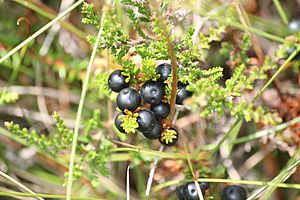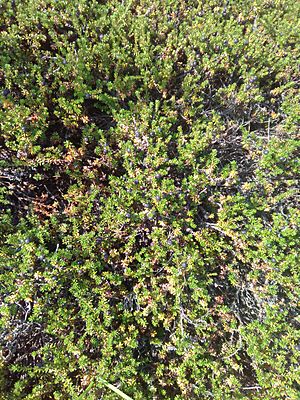Black crowberry facts for kids
Quick facts for kids Black crowberry |
|
|---|---|
 |
|
| Scientific classification | |
| Genus: |
Empetrum
|
| Species: |
nigrum
|
| Synonyms | |
|
|
Empetrum nigrum, crowberry, black crowberry, or, in western Alaska, blackberry, is a flowering plant species in the heather family Ericaceae with a near circumboreal distribution in the northern hemisphere. It is also native in the Falkland Islands. It is usually dioecious, but there is a bisexual tetraploid subspecies, Empetrum nigrum subsp. hermaphroditum, that occurs in more northerly locations and at higher altitude.
Evolutionary biologists have explained the striking geographic distribution of crowberries as a result of long-distance migratory birds dispersing seeds from one pole to the other.
The metabolism and photosynthetic parameters of Empetrum can be altered in winter-warming experiments.
Description
Empetrum nigrum is a low growing, evergreen shrub with a creeping habit. The leaves are 3–6 mm (0.12–0.24 in) long, arranged alternately along the stem. The stems are red when young and then fade to brown. It blooms between May and June, the flowers are small and not very noticeable, with greenish-pink sepals that turn reddish purple. The round fruits are drupes, 4–6 mm (0.16–0.24 in) wide, usually black or purplish-black but occasionally red.
Subspecies
- Empetrum nigrum subsp. asiaticum (Nakai ex H.Ito) Kuvaev – Korean crowberry
- Empetrum nigrum subsp. subholarcticum (V.N.Vassil.) Kuvaev (synonym: Empetrum subholarcticum V.N.Vassil.)
Cultivation and uses
Empetrum nigrum can be grown in acidic soils in shady, moist areas. It can be grown for the edible fruit, (but has an acid -like taste, and can cause headaches ) as a ground cover, or as an ornamental plant in rock gardens, notably the yellow-foliaged cultivar 'Lucia'. The fruit is high in anthocyanin pigment, and can be used to make a natural food dye.
In subarctic areas, E. nigrum has been a vital addition to the diet of the Inuit and the Sami. The Dena'ina (Tanaina) harvest it for food, sometimes storing in quantity for winter, and like it mixed with lard or oil. The fruits are usually collected in fall, but if not picked they may persist on the plant and can be picked in the spring.
The plant is also a food source of several moths including; the Black Mountain, Mountain Burnet and Broad-bordered White Underwing.
See also
 In Spanish: Camarina negra para niños
In Spanish: Camarina negra para niños



